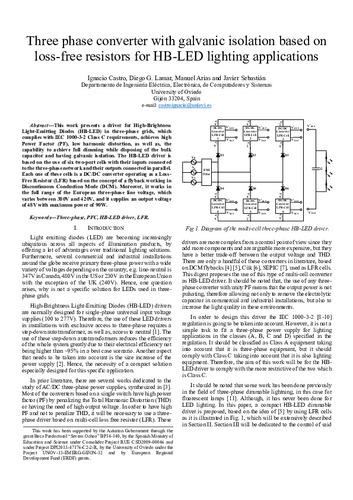Three phase converter with galvanic isolation based on Loss-Free Resistors for HB-LED lighting applications
Palabra(s) clave:
PFC
LFR
Fecha de publicación:
Editorial:
IEEE
Versión del editor:
Descripción física:
Resumen:
This work presents a driver for High-Brightness Light-Emitting Diodes (HB-LED) in three-phase grids, which complies with IEC 1000-3-2 Class C requirements, achieves high Power Factor (PF), low harmonic distortion, as well as, the capability to achieve full dimming while disposing of the bulk capacitor and having galvanic isolation. The HB-LED driver is based on the use of six two-port cells with their inputs connected to the three-phase network and their outputs connected in parallel. Each one of these cells is a DC/DC converter operating as a Loss-Free Resistor (LFR) based on the concept of a flyback working in Discontinuous Conduction Mode (DCM). Moreover, it works in the full range of the European three-phase line voltage, which varies between 380V and 420V, and it supplies an output voltage of 48V with maximum power of 90W
This work presents a driver for High-Brightness Light-Emitting Diodes (HB-LED) in three-phase grids, which complies with IEC 1000-3-2 Class C requirements, achieves high Power Factor (PF), low harmonic distortion, as well as, the capability to achieve full dimming while disposing of the bulk capacitor and having galvanic isolation. The HB-LED driver is based on the use of six two-port cells with their inputs connected to the three-phase network and their outputs connected in parallel. Each one of these cells is a DC/DC converter operating as a Loss-Free Resistor (LFR) based on the concept of a flyback working in Discontinuous Conduction Mode (DCM). Moreover, it works in the full range of the European three-phase line voltage, which varies between 380V and 420V, and it supplies an output voltage of 48V with maximum power of 90W
ISBN:
Patrocinado por:
Asturian Gobernment through the grant Beca Predoctoral “Severo Ochoa” BP14-140, by the Spanish Ministry of Education and Science under Consolider Project RUE CSD2009-00046 and under Project DPI2013-47176-C2-2-R, by the University of Oviedo under the Project UNOV-13-EMERG-GIJON-12 and by European Regional Development Fund (ERDF) grants
Colecciones
Ficheros en el ítem




